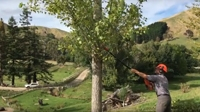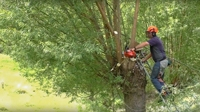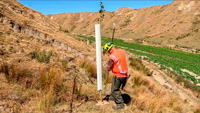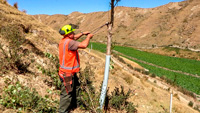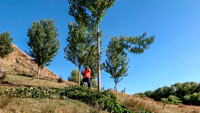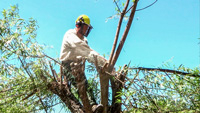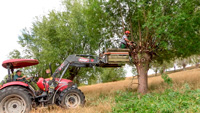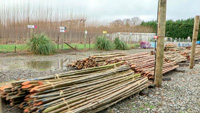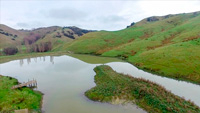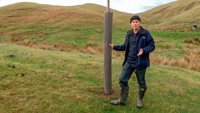Document Library: Cultivation
An index to our poplar and willow documentation
Filter by topic:
Bee Nutrition |
Breeding, Reports |
Diseases, Rust |
Effluent Management |
Erosion Control, Farms, Rivers, Root Systems |
Fodder |
Cultivation, Irrigation, Nutrition |
Pests, Willow Aphid, Willow Sawfly |
Purchasing Poles |
Trees for the Farm |
Poplars |
Willows |
Timber, Milling uses |
Identification Keys
Filter by document type:
Research Briefs |
Fact Sheets |
Videos |
Publications |
Presentations |
Posters |
Newsletters |
Keys
Do I pollard my poplars? - Research Brief 17
What is pollarding? Pollarding is reducing a tree to a stump by removing all branches. For poplars on farms the stump is left at 2 m height so animals cannot eat off the new shoots.
Topics:
Cultivation;
Poplar Information;
Trees for the Farm;
Document Type:
Research Briefs;
Effect of fertilization on growth of poplars established from poles on farmland - Research Brief 16
A single deposit of fertiliser, either N (80g urea), P (180g superphosphate) or both was supplied at 30 cm upslope of the pole and at 15 cm depth to ‘Veronese’ poplar trees on sloping pastoral land two months after the trees were planted as poles.
Topics:
Cultivation;
Nutrition and Fertiliser;
Poplar Information;
Trees for the Farm;
Document Type:
Research Briefs;
Influence of tree shading by Populus ×euramericana ‘Veronese’ - Research Brief 02
We measured and modelled pasture production over a 10-month period under poplar trees aged either 11 or 22 years (TP) and in open pasture (OP), to determine the effect of spaced conservation trees on pasture production.
Topics:
Fodder;
Cultivation;
Poplar Information;
Trees for the Farm;
Document Type:
Research Briefs;
Effect of slope position on poplar growth - Research Brief 13
Trunk diameter data from two wide spaced poplar trials planted in rows, with within row spacing of 10 m, at 20 m apart up a slope are used to provide insights into how slope position affects poplar growth.
Topics:
Erosion Control;
Root Systems;
Cultivation;
Poplar Information;
Trees for the Farm;
Document Type:
Research Briefs;
Influence of soil type on poplar root development - Research Brief 12
Poplar (Populus deltoides × nigra) Trees were grown from 3 m-long poles on pastoral hill slopes in three different soil types, pumice, sandy loam and clay loam, differing in their bulk density.
Topics:
Erosion Control;
Root Systems;
Cultivation;
Poplar Information;
Document Type:
Research Briefs;
Poplar trees and soil properties - Research Brief - 07
This study investigated the effects of poplar tree spacing on soil properties (infiltration rate, bulk density, soil moisture content and soil organic matter content) in two Nelder tree plots, with different soil types.
Topics:
Cultivation;
Poplar Information;
Trees for the Farm;
Document Type:
Research Briefs;
Managing Poplars and Willows: High Pruning Poplars with a Mechanical Pole Saw
How and why to high prune poplar trees.
Topics:
Cultivation;
Poplar Information;
Document Type:
Videos;
Managing Poplars and Willows: Pollarding Older Willows
Older willows can be pollarded to allow them to become a fodder source.
Topics:
Fodder;
Cultivation;
Willow Information;
Document Type:
Videos;
Killing old poplar trees using chemicals
Ian McIvor and Carlo van den Dijssel
Large or old poplar trees planted for soil conservation and now considered a safety risk can be poisoned, killed and left standing using appropriate herbicide applied to the conducting tissue in the trunk.
Topics:
Cultivation;
Poplar Information;
Trees for the Farm;
Document Type:
Publications;
Managing Poplars & Willows: Re-Ramming Recently Planted Poles
Poplar poles sometimes require re-ramming as the summer progresses after recent planting. Re-ramming helps secure the pole and enhance root contact with the soil.
Topics:
Cultivation;
Document Type:
Videos;
Managing Poplars & Willows: Form-Pruning Poplars
Poplars should be form-pruned. Single stems are healthier with greater longevity, allow for better pasture growth and are more likely to produce millable logs.
Topics:
Cultivation;
Document Type:
Videos;
Managing Poplars & Willows: High-Pruning Poplars
Poplars may benefit from high pruning to increase their health and longevity, encourage pasture growth and to produce millable logs.
Topics:
Cultivation;
Document Type:
Videos;
Managing Poplars & Willows: Pollarding Willows from Within the Tree
Pollarding willows is useful to manage tree size when producing fodder for stock and producing planting poles. Safety is a key issue.
Topics:
Fodder;
Cultivation;
Document Type:
Videos;
Managing Poplars & Willows: Pollarding Willows from a Tractor Mounted Box
A tractor mounted bin is a useful way to quickly and easy way to pollard willows on the farm, particularly in flat to easy country. Safety is paramount.
Topics:
Fodder;
Cultivation;
Document Type:
Videos;
Planting Poplars & Willows: Choosing the Best Poles
The best choice depends on your requirements. Get good advice on choosing the right poles in terms of the right size and variety.
Topics:
Cultivation;
Purchasing Poles;
Document Type:
Videos;
Planting Poplars & Willows: Assessing the Site
Learn how to assess hill country sites and place poles for best effect to reduce erosion.
Topics:
Cultivation;
Document Type:
Videos;
Planting Poplars & Willows: Successful Planting
Tips for storage, treatment and planting of poplar and willow poles for successful planting.
Topics:
Cultivation;
Document Type:
Videos;
Growing Poplar and Willow Trees on Farms
Guidelines for Establishing and Managing Poplar and Willow Trees on Farms
Compiled and Prepared by the National Poplar and Willow Users Group
as part of the Sustainable Farming Fund’s Poplar & Willow Project
(Grant No. 04/089)
Topics:
Cultivation;
Trees for the Farm;
Document Type:
Publications;
Trees for the farm
Ian McIvor
A decision support tool for farmers booklet
Topics:
Erosion Control;
Cultivation;
Poplar Information;
Willow Information;
Trees for the Farm;
Document Type:
Publications;
Effect of space-planted ‘Veronese’ poplars on pasture production in hill country
Stephanie Sloan, Peter Kemp, Steve Green & Ian McIvor
A presentation at the IPC Working Party in Gisborne, 2014.
Topics:
Erosion Control;
Farms;
Cultivation;
Document Type:
Presentations;
IPC - Gisborne 2014;
The Search for Grey Poplar Clones That Propagate Easily
R.O. Miller, B.A. Bender, & P. McGovern
A presentation at the IPC Working Party in Gisborne, 2014.
Topics:
Cultivation;
Poplar Information;
Document Type:
Presentations;
IPC - Gisborne 2014;
Survival of Poplar and willow plantings: implications for erosion control
Michael Marden and Chris Phillips
A presentation at the IPC Working Party in Gisborne, 2014.
Topics:
Erosion Control;
Farms;
Cultivation;
Document Type:
Presentations;
IPC - Gisborne 2014;
Root response to removal of shoots in cuttings of willow and poplar
Mauricio Maldonado, Peter D. Kemp, Ian R. McIvor, Grant B. Douglas
A presentation at the IPC Working Party in Gisborne, 2014.
Topics:
Cultivation;
Document Type:
Presentations;
IPC - Gisborne 2014;
Forestry in Sweden
Birger Hjelm
A presentation at the IPC Working Party in Gisborne, 2014.
Topics:
Cultivation;
Poplar Information;
Document Type:
Presentations;
IPC - Gisborne 2014;
Predicting height of coppiced Poplars: a comparison between a traditional and mixed effect model
Birger Hjelm
A presentation at the IPC Working Party in Gisborne, 2014.
Topics:
Cultivation;
Poplar Information;
Document Type:
Presentations;
IPC - Gisborne 2014;
The impact of biogas digestate application on young short rotation willow ecosystem
Katrin Heinsoo
A presentation at the IPC Working Party in Gisborne, 2014.
Topics:
Cultivation;
Nutrition and Fertiliser;
Document Type:
Presentations;
IPC - Gisborne 2014;
Pasture-tree systems: effect on soil carbon accumulation
Grant Douglas, Ronaldo Vibart, Alec Mackay , Mike Dodd (AgResearch) & Ian McIvor (Plant & Food Research)
A presentation at the IPC Working Party in Gisborne, 2014.
Topics:
Erosion Control;
Farms;
Cultivation;
Document Type:
Presentations;
IPC - Gisborne 2014;
Endophytes for Increased Rooting and Better Growth
Sharon Doty
A presentation at the IPC Working Party in Gisborne, 2014.
Topics:
Cultivation;
Document Type:
Presentations;
IPC - Gisborne 2014;
Environmental impact of commercial poplar and willow short rotation forestry stands on water and soil
I. Dimitriou, P. Aronsson & B. Mola
A presentation at the IPC Working Party in Gisborne, 2014.
Topics:
Erosion Control;
Cultivation;
Document Type:
Presentations;
IPC - Gisborne 2014;
Nutrient and irrigation requirements for poplar pole production
Topics:
Cultivation;
Cultivation;
Cultivation;
Cultivation;
Cultivation;
Cultivation;
Cultivation;
Cultivation;
Cultivation;
Irrigation;
Nutrition and Fertiliser;
Document Type:
Literature Review – Fertilisers and Poplars
Topics:
Cultivation;
Cultivation;
Cultivation;
Cultivation;
Nutrition and Fertiliser;
Document Type:
Factsheet 1: Why Plant Poplars and willows on Farms?
Topics:
Cultivation;
Document Type:
Fact Sheets;
Filter by topic: Bee Nutrition | Breeding, Reports | Diseases, Rust | Effluent Management | Erosion Control, Farms, Rivers, Root Systems | Fodder | Cultivation, Irrigation, Nutrition | Pests, Willow Aphid, Willow Sawfly | Purchasing Poles | Trees for the Farm | Poplars | Willows | Timber, Milling uses | Identification Keys
Filter by document type: Research Briefs | Fact Sheets | Videos | Publications | Presentations | Posters | Newsletters | Keys
Do I pollard my poplars? - Research Brief 17
What is pollarding? Pollarding is reducing a tree to a stump by removing all branches. For poplars on farms the stump is left at 2 m height so animals cannot eat off the new shoots.
Topics: Cultivation; Poplar Information; Trees for the Farm;
Document Type: Research Briefs;
Effect of fertilization on growth of poplars established from poles on farmland - Research Brief 16
A single deposit of fertiliser, either N (80g urea), P (180g superphosphate) or both was supplied at 30 cm upslope of the pole and at 15 cm depth to ‘Veronese’ poplar trees on sloping pastoral land two months after the trees were planted as poles.
Topics: Cultivation; Nutrition and Fertiliser; Poplar Information; Trees for the Farm;
Document Type: Research Briefs;
Influence of tree shading by Populus ×euramericana ‘Veronese’ - Research Brief 02
We measured and modelled pasture production over a 10-month period under poplar trees aged either 11 or 22 years (TP) and in open pasture (OP), to determine the effect of spaced conservation trees on pasture production.
Topics: Fodder; Cultivation; Poplar Information; Trees for the Farm;
Document Type: Research Briefs;
Effect of slope position on poplar growth - Research Brief 13
Trunk diameter data from two wide spaced poplar trials planted in rows, with within row spacing of 10 m, at 20 m apart up a slope are used to provide insights into how slope position affects poplar growth.
Topics: Erosion Control; Root Systems; Cultivation; Poplar Information; Trees for the Farm;
Document Type: Research Briefs;
Influence of soil type on poplar root development - Research Brief 12
Poplar (Populus deltoides × nigra) Trees were grown from 3 m-long poles on pastoral hill slopes in three different soil types, pumice, sandy loam and clay loam, differing in their bulk density.
Topics: Erosion Control; Root Systems; Cultivation; Poplar Information;
Document Type: Research Briefs;
Poplar trees and soil properties - Research Brief - 07
This study investigated the effects of poplar tree spacing on soil properties (infiltration rate, bulk density, soil moisture content and soil organic matter content) in two Nelder tree plots, with different soil types.
Topics: Cultivation; Poplar Information; Trees for the Farm;
Document Type: Research Briefs;
Managing Poplars and Willows: High Pruning Poplars with a Mechanical Pole Saw
How and why to high prune poplar trees.
Topics: Cultivation; Poplar Information;
Document Type: Videos;
Managing Poplars and Willows: Pollarding Older Willows
Older willows can be pollarded to allow them to become a fodder source.
Topics: Fodder; Cultivation; Willow Information;
Document Type: Videos;
Killing old poplar trees using chemicals
Ian McIvor and Carlo van den Dijssel
Large or old poplar trees planted for soil conservation and now considered a safety risk can be poisoned, killed and left standing using appropriate herbicide applied to the conducting tissue in the trunk.
Topics: Cultivation; Poplar Information; Trees for the Farm;
Document Type: Publications;
Managing Poplars & Willows: Re-Ramming Recently Planted Poles
Poplar poles sometimes require re-ramming as the summer progresses after recent planting. Re-ramming helps secure the pole and enhance root contact with the soil.
Topics: Cultivation;
Document Type: Videos;
Managing Poplars & Willows: Form-Pruning Poplars
Poplars should be form-pruned. Single stems are healthier with greater longevity, allow for better pasture growth and are more likely to produce millable logs.
Topics: Cultivation;
Document Type: Videos;
Managing Poplars & Willows: High-Pruning Poplars
Poplars may benefit from high pruning to increase their health and longevity, encourage pasture growth and to produce millable logs.
Topics: Cultivation;
Document Type: Videos;
Managing Poplars & Willows: Pollarding Willows from Within the Tree
Pollarding willows is useful to manage tree size when producing fodder for stock and producing planting poles. Safety is a key issue.
Topics: Fodder; Cultivation;
Document Type: Videos;
Managing Poplars & Willows: Pollarding Willows from a Tractor Mounted Box
A tractor mounted bin is a useful way to quickly and easy way to pollard willows on the farm, particularly in flat to easy country. Safety is paramount.
Topics: Fodder; Cultivation;
Document Type: Videos;
Planting Poplars & Willows: Choosing the Best Poles
The best choice depends on your requirements. Get good advice on choosing the right poles in terms of the right size and variety.
Topics: Cultivation; Purchasing Poles;
Document Type: Videos;
Planting Poplars & Willows: Assessing the Site
Learn how to assess hill country sites and place poles for best effect to reduce erosion.
Topics: Cultivation;
Document Type: Videos;
Planting Poplars & Willows: Successful Planting
Tips for storage, treatment and planting of poplar and willow poles for successful planting.
Topics: Cultivation;
Document Type: Videos;
Growing Poplar and Willow Trees on Farms
Guidelines for Establishing and Managing Poplar and Willow Trees on Farms Compiled and Prepared by the National Poplar and Willow Users Group as part of the Sustainable Farming Fund’s Poplar & Willow Project (Grant No. 04/089)
Topics: Cultivation; Trees for the Farm;
Document Type: Publications;
Trees for the farm
Ian McIvor
A decision support tool for farmers booklet
Topics: Erosion Control; Cultivation; Poplar Information; Willow Information; Trees for the Farm;
Document Type: Publications;
Effect of space-planted ‘Veronese’ poplars on pasture production in hill country
Stephanie Sloan, Peter Kemp, Steve Green & Ian McIvor
A presentation at the IPC Working Party in Gisborne, 2014.
Topics: Erosion Control; Farms; Cultivation;
Document Type: Presentations; IPC - Gisborne 2014;
The Search for Grey Poplar Clones That Propagate Easily
R.O. Miller, B.A. Bender, & P. McGovern
A presentation at the IPC Working Party in Gisborne, 2014.
Topics: Cultivation; Poplar Information;
Document Type: Presentations; IPC - Gisborne 2014;
Survival of Poplar and willow plantings: implications for erosion control
Michael Marden and Chris Phillips
A presentation at the IPC Working Party in Gisborne, 2014.
Topics: Erosion Control; Farms; Cultivation;
Document Type: Presentations; IPC - Gisborne 2014;
Root response to removal of shoots in cuttings of willow and poplar
Mauricio Maldonado, Peter D. Kemp, Ian R. McIvor, Grant B. Douglas
A presentation at the IPC Working Party in Gisborne, 2014.
Topics: Cultivation;
Document Type: Presentations; IPC - Gisborne 2014;
Forestry in Sweden
Birger Hjelm
A presentation at the IPC Working Party in Gisborne, 2014.
Topics: Cultivation; Poplar Information;
Document Type: Presentations; IPC - Gisborne 2014;
Predicting height of coppiced Poplars: a comparison between a traditional and mixed effect model
Birger Hjelm
A presentation at the IPC Working Party in Gisborne, 2014.
Topics: Cultivation; Poplar Information;
Document Type: Presentations; IPC - Gisborne 2014;
The impact of biogas digestate application on young short rotation willow ecosystem
Katrin Heinsoo
A presentation at the IPC Working Party in Gisborne, 2014.
Topics: Cultivation; Nutrition and Fertiliser;
Document Type: Presentations; IPC - Gisborne 2014;
Pasture-tree systems: effect on soil carbon accumulation
Grant Douglas, Ronaldo Vibart, Alec Mackay , Mike Dodd (AgResearch) & Ian McIvor (Plant & Food Research)
A presentation at the IPC Working Party in Gisborne, 2014.
Topics: Erosion Control; Farms; Cultivation;
Document Type: Presentations; IPC - Gisborne 2014;
Endophytes for Increased Rooting and Better Growth
Sharon Doty
A presentation at the IPC Working Party in Gisborne, 2014.
Topics: Cultivation;
Document Type: Presentations; IPC - Gisborne 2014;
Environmental impact of commercial poplar and willow short rotation forestry stands on water and soil
I. Dimitriou, P. Aronsson & B. Mola
A presentation at the IPC Working Party in Gisborne, 2014.
Topics: Erosion Control; Cultivation;
Document Type: Presentations; IPC - Gisborne 2014;
Nutrient and irrigation requirements for poplar pole production
Topics: Cultivation; Cultivation; Cultivation; Cultivation; Cultivation; Cultivation; Cultivation; Cultivation; Cultivation; Irrigation; Nutrition and Fertiliser;
Document Type:
Literature Review – Fertilisers and Poplars
Topics: Cultivation; Cultivation; Cultivation; Cultivation; Nutrition and Fertiliser;
Document Type:
Factsheet 1: Why Plant Poplars and willows on Farms?
Topics: Cultivation;
Document Type: Fact Sheets;
